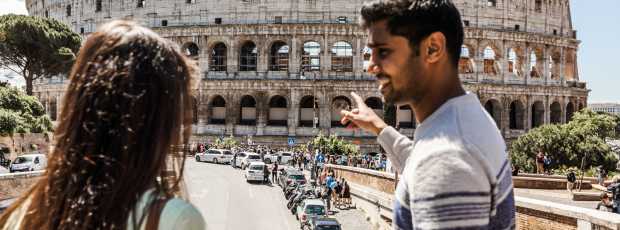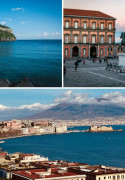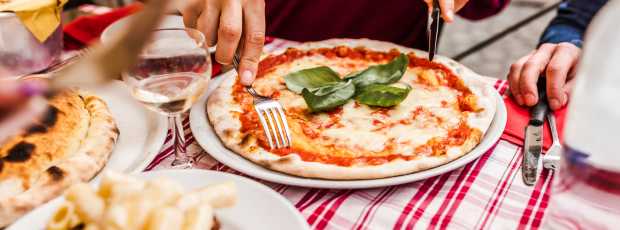Had the most exceptional tour with Nadia, of City Unscripted. I've grown to love this tour company. It's like hiring 'a-professional-best-friend' for a day. And oh man, I got so lucky! My guide Nadia was so kind and friendly.Andrea, Rome, 2025
Taste Rome’s Real Flavors on a Private Food Tour
Private tours, designed around you
Table Of Contents
- Classic Roman Dishes: The Eternal Debates
- Rome’s Food Culture Now: Beyond Ancient Rome
- Street Food Worth Burning Your Fingers For
- Sweet Treats and Desserts: What to Order
- What Romans Drink: Simple Rules
- Neighborhoods Where Food Still Tastes Like Rome
- Food Rituals in Rome: Sunday Lunch and Scarpetta
- Tourist Traps and Spots That Deliver
- Practical Tips for Eating in Rome
- Frequently Asked Questions About What to Eat in Rome
- Eat Like You’re Already Home: That’s Roman Food
My son asked me last week why I still shop at the same market stall my grandmother used sixty years ago. I told him it's because Signora Carla still remembers how Nonna liked her artichokes trimmed, and because some things in Rome don't need to change. That's what to eat in Rome really means. It's not about finding the perfect restaurant or the best gelato. It's about understanding that food here is memory, argument, and rhythm all mixed together with olive oil and time.

Testaccio market vendor arranging fresh artichokes at dawn with customers
I grew up in Testaccio, where the slaughterhouse workers invented half the dishes tourists now eat near the Trevi Fountain. My dog Pepe has stolen more supplì than I've hosted cooking classes, and I've hosted hundreds. When friends visit and ask where to eat in Rome, I take them to the places where the owner will argue with you about pasta water, where the tables wobble, and where you'll eat the best meal of your trip because nobody's performing for you.
This is that conversation. The real one about why carbonara has rules, why the Eternal City still builds every single day around lunch, and how Roman food culture is just Romans being themselves, loud and unapologetic, at a table. These are the Rome experiences that matter most.
Classic Roman Dishes: The Eternal Debates
These are the Roman dishes that define us. Every family has their version, every neighborhood claims it's best, and every single one of us has stopped speaking to someone over technique. These are the classic dishes locals use to judge a kitchen.
Carbonara: Rome’s Most Defended Dish
My friend Marco owns a wine bar in Monti. He's forty-three, been married twice, has a Ducati, and once punched a guy for putting peas in carbonara. That's how seriously Romans take this dish.
Carbonara is eggs, guanciale (cured pork jowl), pecorino romano, black pepper, and nothing else. The egg yolk mixture coats the dried pasta like silk. Crisp guanciale adds crunch. Anyone who tells you it needs cream is selling you something Romans wouldn’t call carbonara.
When I host my market-to-table classes, carbonara is what scares people most. These recipes might be simple, but they’ve fueled generations of arguments and some of the most amazing food you’ll ever taste. The eggs can scramble if your pan is too hot. The pasta water ratio has to be exact. But when you get it right, when that first bite is creamy and sharp and the guanciale fat melts on your tongue, you understand why Romans will stop speaking to relatives over recipe debates.
Armando al Pantheon serves the best carbonara I know outside of home kitchens. The family's been running it since 1961, and they grate the pecorino romano so fine it disappears into the sauce. Book online weeks ahead for dinner, or show up right when they open at 12:30 PM. This is where tourists and locals alike come for the best carbonara, and the long hours mean they serve it from lunch through dinner without compromise.
Cacio e Pepe: Three Ingredients, All Skill
If carbonara is the test, cacio e pepe is the thesis defense. It's just pasta, pecorino romano, black pepper, and pasta water. It's the dish that made my friend Giulia cry when her father died because he'd taught her his water-to-cheese ratio the week before, and she'd never written it down.
The best cacio e pepe in Rome comes from places that have been making it longer than you've been alive. I know a trattoria in Testaccio where the owner is seventy-eight and still won't tell anyone how he gets the pecorino to emulsify without clumping.

Chef tossing cacio e pepe in hollowed pecorino wheel at tableside
You'll see chefs do the tableside thing, tossing cacio e pepe in a giant wheel of pecorino romano. It's a beautiful theater, and when done right, it makes the best cacio e pepe you'll ever taste.
Amatriciana and Gricia: The Tomato Debate
Romans argue about whether Amatriciana or Gricia came first. Amatriciana has tomato sauce. Gricia doesn't. Both have guanciale and pecorino romano. Both taste like Sunday afternoons when you were small and the whole building smelled like pork fat.
I make Amatriciana when I need to feed people I love, because the tomato sauce stretches the portions, and the guanciale fat makes everything taste like home. Emma Pizzeria serves a proper version near the historic center. There’s communal seating, so you’ll end up talking to locals about whether Gricia is just lazy Amatriciana. (It's not. That's fighting words.)
Carciofi alla Romana and alla Giudia: Artichokes Two Ways
Spring in Rome smells like fried artichokes. Every market stall piles them high, still muddy, leaves tight. My grandmother used to trim them with a knife older than my mother, cutting away the tough outer leaves until she found the pale heart. Then she'd either braise them (carciofi alla romana, the Roman style that uses mint and garlic) with olive oil until they fell apart, or fry them twice (carciofi alla giudia) until they opened like bronze flowers and crunched between your teeth.
The Jewish Ghetto version, alla giudia, is the one tourists photograph. But alla romana is the one I crave, braised until the leaves pull apart like wet paper and taste like spring itself.
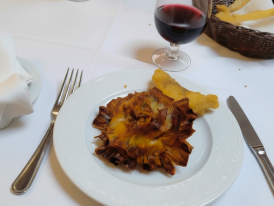
Fried artichokes alla giudia opened like bronze flowers on white plate
When you visit Rome in spring, eating artichokes isn't optional. It's the entire point of the season. Fava beans appear too, eaten raw with pecorino romano and olive oil as a snack that tastes like grass and salt and everything good about April. These Italian specialties define visiting Rome when the weather turns warm.
Saltimbocca and Coda alla Vaccinara: Fast vs Slow Comfort
Saltimbocca means "jumps in the mouth." Veal cutlets topped with prosciutto and sage, cooked in white wine and butter until the meat is so tender you barely need to chew. My mother made this when she wanted to prove she could cook fast and fancy at the same time. It's one of those Italian specialties that looks complicated but takes twenty minutes.
Coda alla vaccinara is why Testaccio matters. Oxtail braised with tomatoes, celery, and cocoa powder for four hours until the meat falls off the bone. We ate what wealthy Romans wouldn't touch and turned it into something people now book tables weeks ahead to try. The best version I know comes from a trattoria where you can smell it from the cobblestone street outside. It's one of those meat dishes that tastes better the next day.
Curious What You Won’t Find Online in Rome?
Discover the side only locals talk about.
Rome’s Food Culture Now: Beyond Ancient Rome
Rome isn't stuck in ancient Rome. Walk through the city center now and you'll find more than just trattorias serving carbonara. My son's favorite meal right now is Nigerian jollof rice from a spot near Termini Station.
The Jewish Ghetto shaped Roman food as much as any trattoria. Carciofi alla giudia, baccalà (salt cod), aliciotti con l'indivia, these all came from Jewish families who've been cooking here since before the Colosseum was built.
Walk through Piazza Vittorio and you'll find Bangladeshi markets next to Eritrean restaurants, sushi bars run by Japanese families, and halal butchers whose lamb is better than anything I can find in Testaccio. Vegan corners are popping up near universities where students argue about chickpea flour the way my generation argued about pasta water. Rome's food culture grows without forgetting where it started.
Street Food Worth Burning Your Fingers For
Street food in Rome is the meal most of us eat three times a week, standing at counters wrapped in paper. This is eating in Rome at its most honest. If you want a day that tastes like the city, build your route around market stops and pizza counters, then mix in a few things to do in Rome between bites.
Supplì: Crunchy Rice, Melting Mozzarella
Supplì is risotto mixed with tomato sauce and mozzarella, shaped into an oval, breaded, and fried until the outside crunches and the inside leaks cheese in strings. Romans call it supplì al telefono because the mozzarella stretches like old phone cords.

Supplì pulled apart at a street counter in Rome
My preferred spot is a stall in Testaccio run by three generations of the same family. They fry them to order. You eat them standing, wrapped in wax paper, burning your fingers because you couldn't wait thirty seconds. Pepe, my dog, has learned to sit very close to me when I'm eating supplì.
Pizza al Taglio and Trapizzino: Fast, Filling, and Local
Pizza al taglio means pizza by the cut. You point, they weigh it, you pay by the gram. Forno Campo de' Fiori is famous because their pizza rossa (just tomato sauce and olive oil) is almost sweet from good tomatoes, and the olive oil pools in the dimples. Go before noon or accept the long lines. This is the best pizza in Rome if you measure it by how often locals eat it.
Trapizzino is a triangle of pizza dough stuffed with Roman stews like chicken cacciatore, oxtail, or eggplant parmigiana. Invented in 2008, but it caught on because it solved a problem: how do you eat a full meal while walking? When I'm running between hosting tours and picking up my son, a trapizzino works.
The best desserts in Rome are never trying to impress you.
Sweet Treats and Desserts: What to Order
Romans eat sweet things in the morning with coffee, or we end a meal with something simple. The best desserts in Rome are never trying to impress you.
Maritozzo, Tiramisù, and Gelato: Spotting the Good Stuff
Maritozzo is a soft brioche bun stuffed with whipped cream so thick it doesn't collapse when you bite down. You eat it for breakfast, dipped in espresso, standing at a bar at 7 AM. My grandmother said men used to hide engagement rings inside the whipped cream.

Maritozzi and morning coffee on a café table in Rome
Ai Tre Scalini makes a tiramisù that's less sweet than most tourist versions, with dark chocolate shavings on top. It's the kind of dessert that ends a long dinner without making you regret the pasta course.
For the best gelato, look for dull colors and flavors that don't pile into tall peaks (that's added air and stabilizers). Real pistachio looks grayish, not neon. My son's favorite place makes a dark chocolate flavor with olive oil that tastes savory and sweet at once.
Don’t Just Visit. Feel Part of It.
Locals share their city as they live it, so even a few hours can feel like you truly belong.
Discover the differenceWhat Romans Drink: Simple Rules
Drinking in Rome has rules, but they're the practical kind. Romans drink white wine with seafood and red wine with meat dishes because those combinations work. Every restaurant has a wine list, even the ones with plastic chairs.
Frascati is the local white wine, crisp and cheap, served in carafes at neighborhood trattorias. Don't be shy about asking the owner for wine list recommendations. They'll usually steer you toward something local and good.
Aperol spritz is what tourists order when they don't know what else to ask for. Romans drink it too, but usually before dinner. If you want to blend in, order a glass of white wine or a Negroni.
Coffee has stricter rules. Cappuccino before noon only, espresso after meals, never with pasta. The reasoning is simple: milk is heavy and fills you up, so you drink it in the morning. After lunch, you want a quick shot of caffeine that doesn't sit in your stomach. If you order a cappuccino at 3 PM, no one will stop you. But they'll know you're not from here. Popular belief says these rules are about digestion. The truth is, they're about rhythm.
Neighborhoods Where Food Still Tastes Like Rome
Every neighborhood in Rome has its own eating rhythm, its own favorite restaurants, its own arguments about which bakery makes the best pizza rossa. These are the places where local dishes still taste the way they're supposed to.
Testaccio’s old slaughterhouse shaped what the neighborhood eats today. The market here is where I shop, and where Signora Carla knows how I like my pecorino romano cut. When people ask me where to eat in Rome like a local, I bring them to this local place.
The Jewish Ghetto is best in late afternoon when the light hits the synagogue and bakeries pull fresh trays. The air smells of warm baked goods, from ricotta tarts to braided challah, still cooling on the racks.

Campo de Fiori morning market with flower stalls and vegetable vendors
Trastevere has cobblestone streets and ivy-covered walls, but too many tourists. Slip into the side streets and you’ll find outdoor tables filling as the light softens. Skip restaurants with photo menus. Head to places where locals are waiting for tables. Monti is younger, quieter, and full of wine bars serving natural wine and small plates. It’s where Romans go when they want to eat well without fighting crowds near the Vatican Museums.
Tip: Eat Like a Local, Not a Visitor
Skip scripted stops. With City Unscripted, your host leads you to the spots Romans trust for the dishes that matter.Food Rituals in Rome: Sunday Lunch and Scarpetta
Sunday lunch in Rome is sacred. Families gather around 1 PM and stay for hours. My son complains about it now, but he'll understand when he's older that the meal is the point. These long hours at the table, eating pasta dish after pasta dish, are what define us.
The scarpetta is the ritual of mopping up sauce with bread at the end of a meal. It's considered good manners here, not rude. If you leave sauce on your plate, you're wasting it, and waste is the only real food crime in Rome.
We eat seasonally without thinking about it. Spring means fava beans with pecorino romano. Summer is tomatoes and cold pasta salads when it's 95°F (35°C) outside. Fall brings porcini mushrooms. Winter is when we braise oxtail. The market dictates the seasonal menu.
Restaurants don't rush you. Dinner starts around 8 or 9 PM and lasts as long as you want. No one brings the check until you ask. The long hours we spend eating dinner are part of the experience, not something to apologize for.
Google Can’t Answer This One
A local can — in a 1-to-1 video call tailored to your trip.
Tourist Traps and Spots That Deliver
The Trevi Fountain is gorgeous. The restaurants around it will rob you. Walk ten minutes in any direction from major tourist sites and you'll find better food at half the price. Walk two blocks off any postcard view and the mom-and-pop kitchens start to appear, real hidden gems in Rome that don’t need to shout for your attention.
Armando at the Pantheon deserves its reputation. It’s been open since 1961. The carbonara tastes like my grandmother's kitchen, and the cacio e pepe is flawless. Tables go fast at Armando al Pantheon. Plan ahead. My neighbor's daughter works there, and she says they go through forty eggs every Sunday before lunch ends.
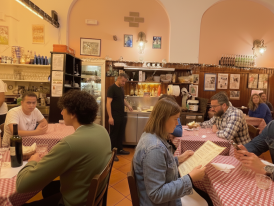
A casual trattoria in Rome filled with locals at lunchtime
Emma Pizzeria near Campo de' Fiori is fine. Good pizza in a nice location with consistent quality. Ai Tre Scalini in Monti serves generous portions of Roman classics at fair prices. A local place that tourists discovered, which means it's crowded, but the food is still good.
Trust your instincts. If a place feels like a trap, with aggressive staff pulling you inside and menus in eight languages, it probably is.
Practical Tips for Eating in Rome
Book online for popular spots, especially during peak season (April to October). Some places don't take reservations, and you'll see long lines at pizza al taglio spots. Go early or accept the wait. When visiting Rome, planning ahead for dinner makes everything easier.
You can wear jeans to dinner in Rome. Dress codes are relaxed here. Tipping isn't required. Most restaurants include a service charge (coperto) on the bill. A good meal costs between €15 and €30 per person. Tourist areas charge more. Neighborhood trattorias charge less and often taste better.
Most older restaurants aren't fully step-free. Testaccio Market has ramps, but many traditional spots have stairs. One exception is newer places in Monti, which tend to be more accessible. Online bookings are standard now at popular restaurants. Book a few days to a week ahead for dinner.
Frequently Asked Questions About What to Eat in Rome
1) What is a famous food in Rome?
Carbonara, cacio e pepe, and pizza al taglio lead the pack. They are simple, Roman classics done with care.
2) When do Romans eat their main meals?
Lunch is usually from 12:30 to 2:30 PM. Dinner starts around 8 to 9:30 PM, and nobody rushes.
3) Do I need reservations at restaurants in Rome?
For small or famous spots, yes. Book online a few days ahead to skip long lines.
4) Where can I find the best pizza in Rome?
Forno Campo de’ Fiori is great for pizza al taglio. Emma Pizzeria is a solid sit-down choice, and neighborhood bakeries make excellent pizza rossa.
5) What’s the best gelato in Rome, and how do I spot it?
Choose places with natural colors and seasonal flavors. Avoid neon shades and giant whipped peaks.
6) What should I eat in Rome besides pasta and pizza?
Try fried artichokes, supplì, saltimbocca, and oxtail stew. Finish with a maritozzo filled with whipped cream.
7) Is street food safe in Rome?
Yes, especially at busy counters where food turns over fast. Supplì, trapizzino, and pizza al taglio are local favorites.
8) Can I wear jeans to dinner in Rome?
Absolutely. Romans dress neatly but casually unless it is a special occasion.
9) How do tipping and the bill work?
Service is usually included, so just round up for good service. Ask for the check when you are ready.
10) Can I drink tap water in Rome?
Yes, it is safe and tasty. Refill at the public nasoni fountains to save money.
Eat Like You’re Already Home: That’s Roman Food
Food in Rome isn't about checking boxes. It's about understanding that a meal is a conversation, that carbonara has rules for reasons, and that the best dishes are the ones your neighbor's grandmother still makes every Sunday using the same pot she's used for forty years.
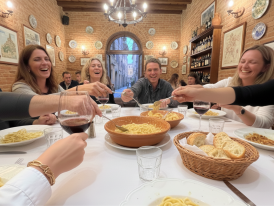
Family dinner table with hands reaching for pasta, wine glasses, and bread crumbs
When I host guests through my market-to-table experiences, I tell them what I'm telling you now. Eat where you see Romans eating. Ask questions. Mop up sauce with bread. Order the same pasta dish three days straight if you love it. The Italy experiences you'll remember aren't the expensive ones. They're the ones where you stayed too long at a marble counter, drank too much red wine, and let a stranger tell you about their nonna's ragù while you both just ate.
Visit Rome. Eat like we do. Leave with a full belly and stories worth repeating. That's the real Rome food guide, and it's been working for centuries. Come hungry. Leave full. Remember the black pepper.
Keep Exploring Italy
Ready to Plan Your Perfect Day in Rome?
Start your experienceWhat if Your Day in Rome Was Planned by Someone Who Knows It — and You?
City Unscripted matches you with a local host who creates a private experience based on your interests, not a set route.
Learn more about usWant to Experience the Real Rome With Someone Who Lives There?
A fully private experience, planned and led by a local host who tailors the day to you
Meet Your Rome Hosts
Hungry to Try Rome Yourself?
Taste and explore the flavors locals actually love.




